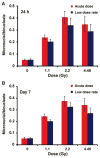Effect of dose rate on residual γ-H2AX levels and frequency of micronuclei in X-irradiated mouse lymphocytes
- PMID: 25738897
- PMCID: PMC4545272
- DOI: 10.1667/RR13860.1
Effect of dose rate on residual γ-H2AX levels and frequency of micronuclei in X-irradiated mouse lymphocytes
Abstract
The biological risks associated with low-dose-rate (LDR) radiation exposures are not yet well defined. To assess the risk related to DNA damage, we compared the yields of two established biodosimetry end points, γ-H2AX and micronuclei (MNi), in peripheral mouse blood lymphocytes after prolonged in vivo exposure to LDR X rays (0.31 cGy/min) vs. acute high-dose-rate (HDR) exposure (1.03 Gy/min). C57BL/6 mice were total-body irradiated with 320 kVP X rays with doses of 0, 1.1, 2.2 and 4.45 Gy. Residual levels of total γ-H2AX fluorescence in lymphocytes isolated 24 h after the start of irradiation were assessed using indirect immunofluorescence methods. The terminal deoxynucleotidyl transferase dUTP nick end labeling (TUNEL) assay was used to determine apoptotic cell frequency in lymphocytes sampled at 24 h. Curve fitting analysis suggested that the dose response for γ-H2AX yields after acute exposures could be described by a linear dependence. In contrast, a linear-quadratic dose-response shape was more appropriate for LDR exposure (perhaps reflecting differences in repair time after different LDR doses). Dose-rate sparing effects (P < 0.05) were observed at doses ≤2.2 Gy, such that the acute dose γ-H2AX and TUNEL-positive cell yields were significantly larger than the equivalent LDR yields. At the 4.45 Gy dose there was no difference in γ-H2AX expression between the two dose rates, whereas there was a two- to threefold increase in apoptosis in the LDR samples compared to the equivalent 4.45 Gy acute dose. Micronuclei yields were measured at 24 h and 7 days using the in vitro cytokinesis-blocked micronucleus (CBMN) assay. The results showed that MNi yields increased up to 2.2 Gy with no further increase at 4.45 Gy and with no detectable dose-rate effect across the dose range 24 h or 7 days post exposure. In conclusion, the γ-H2AX biomarker showed higher sensitivity to measure dose-rate effects after low-dose LDR X rays compared to MNi formation; however, confounding factors such as variable repair times post exposure, increased cell killing and cell cycle block likely contributed to the yields of MNi with accumulating doses of ionizing radiation.
Figures




Similar articles
-
Effect of subsequent acute-dose irradiation on cell survival in vitro following low dose-rate exposures.Int J Radiat Biol. 2002 Nov;78(11):981-90. doi: 10.1080/0955300021006589. Int J Radiat Biol. 2002. PMID: 12456285
-
Influence of dose-rate, post-irradiation incubation time and growth factors on interphase cell death by apoptosis and clonogenic survival of human peripheral lymphocytes.Int J Radiat Biol. 1999 Oct;75(10):1265-73. doi: 10.1080/095530099139421. Int J Radiat Biol. 1999. PMID: 10549603
-
Low-dose radiation modifies skin response to acute gamma-rays and protons.In Vivo. 2013 Nov-Dec;27(6):695-700. In Vivo. 2013. PMID: 24292570
-
The adaptive response in radiobiology: evolving insights and implications.Environ Health Perspect. 1998 Feb;106 Suppl 1(Suppl 1):277-83. doi: 10.1289/ehp.98106s1277. Environ Health Perspect. 1998. PMID: 9539019 Free PMC article. Review.
-
Low dose hyper-radiosensitivity and increased radioresistance in mammalian cells.Int J Radiat Biol. 1997 Jun;71(6):721-35. doi: 10.1080/095530097143725. Int J Radiat Biol. 1997. PMID: 9246186 Review.
Cited by
-
Effect of dose and dose rate on temporal γ-H2AX kinetics in mouse blood and spleen mononuclear cells in vivo following Cesium-137 administration.BMC Mol Cell Biol. 2019 May 28;20(1):13. doi: 10.1186/s12860-019-0195-2. BMC Mol Cell Biol. 2019. PMID: 31138230 Free PMC article.
-
Cytogenetic Damage of Human Lymphocytes in Humanized Mice Exposed to Neutrons and X Rays 24 h After Exposure.Cytogenet Genome Res. 2021;161(6-7):352-361. doi: 10.1159/000516529. Epub 2021 Sep 6. Cytogenet Genome Res. 2021. PMID: 34488220 Free PMC article.
-
Development of a high-throughput γ-H2AX assay based on imaging flow cytometry.Radiat Oncol. 2019 Aug 22;14(1):150. doi: 10.1186/s13014-019-1344-7. Radiat Oncol. 2019. PMID: 31438980 Free PMC article.
-
Can high dose rates used in cancer radiotherapy change therapeutic effectiveness?Contemp Oncol (Pozn). 2016;20(6):449-452. doi: 10.5114/wo.2016.65603. Epub 2017 Jan 12. Contemp Oncol (Pozn). 2016. PMID: 28239281 Free PMC article. Review.
-
γ-H2AX Kinetic Profile in Mouse Lymphocytes Exposed to the Internal Emitters Cesium-137 and Strontium-90.PLoS One. 2015 Nov 30;10(11):e0143815. doi: 10.1371/journal.pone.0143815. eCollection 2015. PLoS One. 2015. PMID: 26618801 Free PMC article.
References
-
- Grace MB, Moyer BR, Prasher J, Cliffer KD, Ramakrishnan N, Kaminski J, et al. Rapid radiation dose assessment for radiological public health emergencies: roles of NIAID and BARDA. Health Phys. 2010;98:172–8. - PubMed
-
- National planning scenarios, version 21.3. Washington DC: Homeland Security Council; 2006. ( http://bit.ly/1udh6Y5)
-
- Hall EJ. Radiation dose-rate: a factor of importance in radiobiology and radiotherapy. Br J Radiol. 1972;45:81–97. - PubMed
-
- Hall EJ, Brenner DJ. The dose-rate effect revisited: radiobiological considerations of importance in radiotherapy. Int J Radiat Oncol Biol Phys. 1991;21:1403–14. - PubMed
-
- Hall EJ, Bedford JS. Dose rate: its effect on the survival of HeLa cells irradiated with gamma rays. Radiat Res. 1964;22:305–15. - PubMed
Publication types
MeSH terms
Substances
Grants and funding
LinkOut - more resources
Full Text Sources

